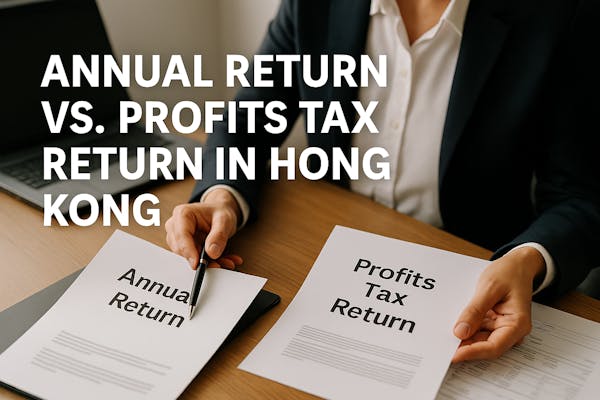The Annual Return is filed with the Companies Registry to report a company’s structure and officers.
The Profits Tax Return is filed with the Inland Revenue Department (IRD) to report income and pay taxes.
The Annual Return is due within 42 days of a company’s incorporation anniversary.
The Profits Tax Return is due based on your financial year-end, with common block extension deadlines available.
Filing both forms on time, with accurate documents, helps avoid penalties, secure tax benefits, and keep operations compliant and uninterrupted.
In Hong Kong, staying compliant with government filing requirements is a legal obligation for every business. Two key forms that companies must file each year are the Annual Return and the Profits Tax Return. While both are mandatory, they serve different purposes and are submitted to different government departments.
This guide explains the difference between the two filings, what each form includes, and the penalties for missing deadlines.
What Is an Annual Return?
Every company registered in Hong Kong must file an Annual Return (Form NAR1) with the Companies Registry. This return gives the government an updated summary of the company’s current information and helps maintain public records.
What’s Inside an Annual Return?
When filling out the Annual Return (Form NAR1), it’s important to provide some necessary details about the company. Here’s what it usually includes:
- Company name and registration number
- Registered office address
- Company type (e.g., private or public)
- Share capital details
- Names and details of directors, shareholders (if applicable), and the company secretary
When Do You Need to File the Annual Return?
For private companies, the Annual Return must be filed within 42 days after each anniversary of incorporation.
For public companies and companies limited by guarantee, different deadlines apply. These are usually tied to the company’s financial year-end and must be submitted within 42 days after the return date (defined by law).
Late Filing Penalties
As of 2025, penalties for late filing range from:
- HK$870 (up to 1 month late)
- HK$1,740 (more than 1 month but less than 3 months late)
- HK$2,610 (3–6 months late)
- HK$3,480 (over 6 months late)
How to File Your Annual Return
You can file your Annual Return in two ways:
- Online: Through the e-Registry portal operated by the Companies Registry. It’s available 24/7 and is the fastest option.
- By Mail: Paper filings are accepted but are slower and risk postal delays.
What Is a Profits Tax Return?
The Profits Tax Return (PTR) is issued by the Inland Revenue Department (IRD) and is used to report a business’s financial performance for the year. It shows how much profit was made and how much is owed.
Understanding The Filing Process
The IRD issues PTRs on the first working day of April each year.
For the 2024/25 tax year, forms were sent out on 1 April 2025.
Starting from the 2025/26 Year of Assessment, electronic filing of Profits Tax Returns via the eTAX platform is mandatory in Hong Kong. Paper submissions are only permitted with prior approval from the Inland Revenue Department (IRD).
Filing Deadline
Businesses usually have 1 month to file after receiving the form.
| Return Type | Accounting Date | Extended Due Date | Electronic Filing Extended Due Date |
|---|---|---|---|
| N Code Returns | 1 April – 30 November | No extension | 2 June (following year) |
| D Code Returns | 1 – 31 December | 15 August | 15 September |
| M Code Returns | 1 January – 31 March | 17 November | 17 December |
| M Code Returns with Current Year Loss | 1 January – 31 March | 2 February (second year after year-end) | 2 February (second year after year-end) |
“N Code” is for companies with accounting year-ends between 1 April and 30 November.
“D Code” is for companies with a December year-end (1–31 December).
“M Code” is for companies with year-ends between 1 January and 31 March.
“Current Year Loss Cases” are M Code returns where the company has incurred a loss during the basis period for the year of assessment.
What to Include in Your Profits Tax Return
When filing the PTR, companies typically must submit:
- Audited financial statements
- Tax computation showing how assessable profits are calculated, and
- Supporting documents, such as:
- IR56E, IR56F, IR56G forms (for employee reporting)
- Form S3 – For R&D tax deduction claims
- Form S4 – For energy-efficient asset deductions
- Form S19 – To report foreign-sourced income
- Form S21 – To apply for the Tax Certainty Enhancement Scheme
- Form S22 – To claim the 5% tax rate under the Patent Box incentive
Supplementary Forms for Your Profits Tax Return
When filing a Profits Tax Return in Hong Kong, the process is not always uniform. Depending on how a business operates, particularly if it is scaling quickly, engaging in research and development, or conducting transactions with related entities, additional supplementary forms may be required.
These forms offer further clarity and help ensure compliance with specific tax regulations or eligibility for tax incentives.
| Form | Purpose |
|---|---|
| S1 – Two-Tiered Tax Rate Election | Elect to apply the two-tiered tax rate (8.25% on first HK$2M, 16.5% thereafter) |
| S2 – Transfer Pricing Disclosure | Required for related-party or cross-border transactions to ensure proper reporting. |
| S3 – R&D Tax Incentive Declaration | Claim R&D deductions for qualifying expenses, especially when grants or funding are involved. |
| S4 – Energy Efficiency Deductions | Claim deductions for eco-friendly upgrades (e.g. solar panels). May affect income and property tax. |
| S19 – Foreign-Sourced Income Disclosure | Report offshore income for exemption eligibility under the new foreign-sourced income rules. |
| S21 – Tax Certainty Enhancement Scheme | Apply for advance certainty on complex tax issues to avoid future disputes. |
| S22 – Patent Box Incentive | Claim the 5% tax rate on eligible IP income under the Patent Box regime. |
Differences Between Annual Return and Profits Tax Return
Let’s look at how the Annual Return and Profits Tax Return are different in Hong Kong. Here is an easy chart to help understand:
| Feature | Annual Return | Profits Tax Return |
|---|---|---|
| Purpose | Reports company structure and officers | Reports income and tax obligations |
| Submitted to | Companies Registry | Inland Revenue Department (IRD) |
| Form | NAR1 | BIR51 (corporations), BIR52 (partnerships), BIR54 (non-residents) |
| Filing Frequency | Annually | Annually |
| Deadline | Within 42 days of incorporation anniversary | Depends on financial year-end (see block scheme) |
| Filing Method | e-Registry or by mail | eTAX (mandatory from 2025/26) |
| Penalties | HK$870–HK$3,480 based on delay | Fixed fines, additional tax, or prosecution under Cap. 112 |
Penalties for Late Filing
Penalties under the Inland Revenue Ordinance (Cap. 112) may include:
- Fixed fine: HK$1,200 to HK$3,000
- Additional tax: Up to three times the underpaid amount
- Prosecution: Up to HK$50,000 fine and 3 years’ imprisonment in serious cases
Repeat or deliberate non-compliance can lead to criminal charges under Section 82A of the IRO.
Conclusion
Both the Annual Return and Profits Tax Return are mandatory filings for companies in Hong Kong. They serve different legal and financial purposes and are submitted to different government bodies.
Missing deadlines can be costly, so it’s essential to stay informed and file on time.
If you need help managing your company’s compliance, Air Corporate can take care of your Annual Return, Profits Tax Return, and other filing obligations—so you can focus on growing your business.
FAQs
Hong Kong uses a two-tiered tax system for corporations:
- 8.25% on the first HK$2 million of profits
- 16.5% on profits above HK$2 million
For unincorporated businesses (e.g. sole proprietorships, partnerships), the flat rate is 15%.
- Annual Return: Filed with the Companies Registry, showing your company’s structure (directors, shareholders, etc.).
- Profits Tax Return: Filed with the Inland Revenue Department (IRD), reporting income and tax matters.
They serve different purposes and are submitted to separate government bodies.
Yes. Both the Annual Return and the Profits Tax Return are filed annually, and missing either can lead to penalties or fines.



